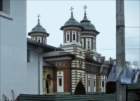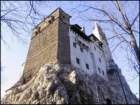 |
 |
 |
 |
 |
 |
 |
 |
 |
 |
Page 37:
Day 24, November 14, 2005 - Bran Romania
People who are flying out in the morning have their names up on the Hotel information board for their time to put out their bags and to catch the shuttle bus to the airport. We are not on the list, as our travel Agent, Maria Taylor, had told us to catch a taxi out to the airport and Trafalgar would re-imburse us. We have a choice to be put on the board, also, but Pat opts for the taxi, thinking that we would get out a few minutes before the bus and possibly get the seats with long leg room on our flight, again. We have a wake up call for 3:15 to catch our 3:45 taxi (has become a lemo for the same price as a taxi). In the morning we get to the airport, nicely on time, but the good seats are taken. As we sit and wait for our flight departure time we see the rest of the group trudging in, in dribs and drabs. Apparently the Hotel never did get a free shuttle bus for them and they all had to arrange taxis, catch as catch can. What a nasty send off for them. Everyone should have a travel agent like our Maria. As I type this in October 2022, Maria has been retired for a few years. We have not found a good travel agent since her retirement.
Excerpts from information provided: Today’s Romanians are in part descended from the Getae, a Thracian tribe that lived north of the Danube River. By the middle of the third century A.D. major migrations of barbarian tribes had begun. The Visigoths, Huns, Ostrogoths, Gepids and Lombards swept over the land from the third – fifth centuries, and the Avars arrived in the sixth century, along with a steady flow of Slavic peasants. Unlike other tribes, the Slavs settled the land and intermarried with the Dacians, which is what the native people were called at the time. In 676 the Bulgar Empire absorbed a large portion of ancient Dacia.
The migration period brought linguistic and religious change to Dacia. The Dacians assimilated many Slavic words into their lexicon and, although modern Romanian is a Romance language, some linguists estimate that half of its words have Slavic roots. The Slavonic rite would be maintained until the seventeenth century, when Romanian became the liturgical language.
| Home | About | Gardening | Photography | Travel | Victoria | Guestbook | Blog | Links | Series | MyWalk | Car Stuff | ||||||||||||||||
Uploaded: November 30, 2022
Photo album created by M. M. Meehan
Photo album created with Web Album Generator